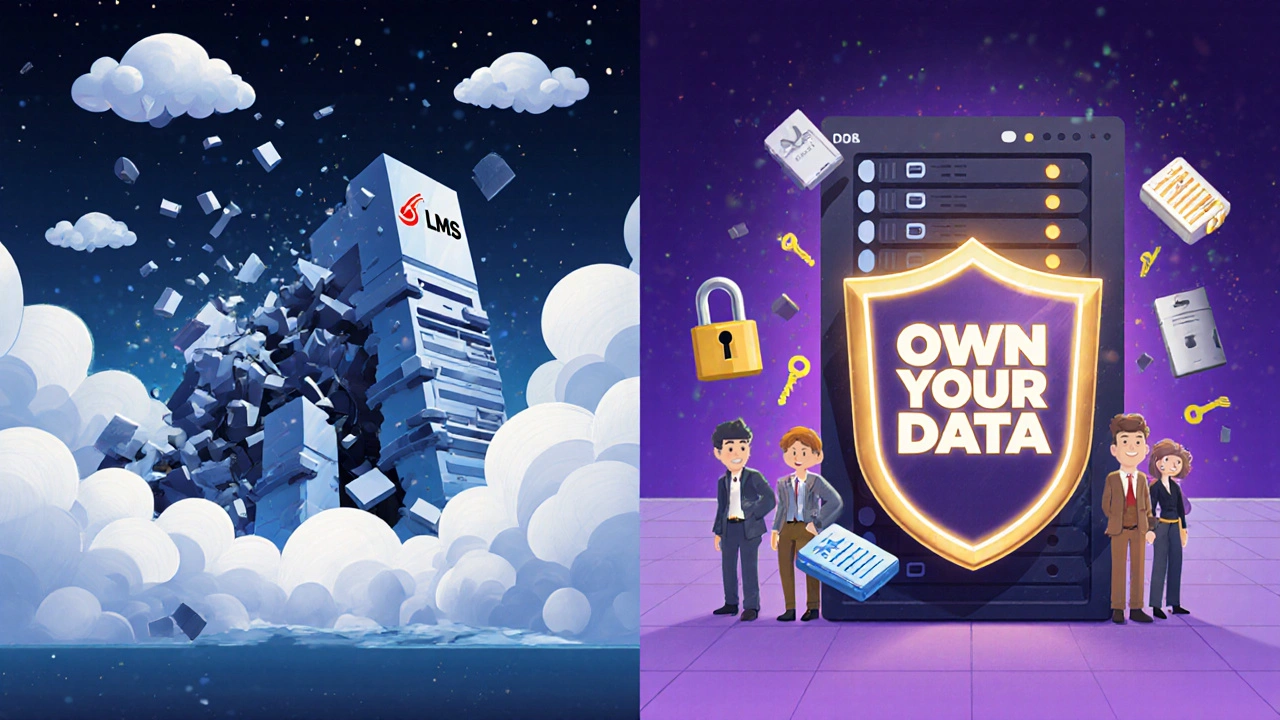Cloud-Based vs Self-Hosted LMS: Which Is Right for Your Organization?
 Nov, 8 2025
Nov, 8 2025
Choosing between a cloud-based LMS and a self-hosted LMS isn’t just about technology-it’s about control, budget, and long-term scalability. If you’re managing training for 50 employees or 5,000 students, the decision you make today will shape your operations for years. There’s no one-size-fits-all answer, but understanding the real trade-offs-beyond marketing buzzwords-can save you time, money, and headaches.
What Is a Cloud-Based LMS?
A cloud-based LMS runs entirely on someone else’s servers. You sign up, log in, and start using it. No installing software. No managing hardware. Think of it like Netflix: you don’t own the servers that stream your shows, but you get instant access. Popular examples include Canvas, TalentLMS, and Docebo.
Most cloud-based platforms charge a monthly or annual fee per user. For a mid-sized company with 200 learners, that’s often $2,000 to $5,000 a year. Some include features like mobile apps, reporting dashboards, and integrations with Zoom or Slack. Others charge extra for those.
The biggest perk? Updates happen automatically. If the vendor adds a new quiz type or fixes a security flaw, you get it the next time you log in. No IT team needed. That’s why schools and small businesses love it. But you’re locked into their roadmap. If you want a feature they don’t offer, you’re out of luck.
What Is a Self-Hosted LMS?
A self-hosted LMS lives on your own servers-or a server you rent from a provider like AWS or Linode. You install, configure, and maintain it yourself. Moodle and Chamilo are the most common open-source options. Some companies build custom versions from scratch.
Upfront costs can be high. You’ll need a server, a database, SSL certificates, backup systems, and someone to manage it all. For a small team, expect $10,000 to $25,000 just to get started. Ongoing costs include monthly hosting ($100-$500), security patches, and staff time. If your IT person leaves, you might lose access to your entire training system.
But here’s the upside: total control. You can modify the code. Add custom reports. Integrate with your HR system, CRM, or internal tools. You own your data. No vendor can change pricing, drop a feature, or go out of business and leave you stranded.
Cost Comparison: What You’re Really Paying
Cloud-based LMS looks cheaper on paper. But let’s break down what’s hidden.
| Cost Factor | Cloud-Based LMS | Self-Hosted LMS |
|---|---|---|
| Upfront Setup | $0-$500 (onboarding fee) | $8,000-$25,000 (servers, licenses, installation) |
| Monthly Fee | $5-$15 per user | $100-$500 (hosting + maintenance) |
| Per-User Cost (200 users) | $12,000-$36,000/year | $200-$1,000/year |
| Custom Features | $10,000+ (if vendor builds it) | $0-$15,000 (if you hire a dev) |
| Training & Support | Usually included | $5,000-$15,000 (internal or outsourced) |
| Total (3 years, 200 users) | $36,000-$108,000 | $30,000-$85,000 |
After year three, the self-hosted option often becomes cheaper-if you have the staff to manage it. But if you’re paying an IT contractor $80/hour to fix bugs, the savings vanish fast.
Security: Who’s Really in Control?
Many assume cloud-based is less secure. That’s a myth. Top cloud LMS providers spend millions on security. They use encryption, regular audits, SOC 2 compliance, and 24/7 monitoring. Many follow HIPAA and GDPR standards. If you’re in healthcare or education, they’re often more compliant than you could be on your own.
Self-hosted gives you physical control. Your data never leaves your network. That’s critical for government agencies, defense contractors, or banks with strict data residency rules. But here’s the catch: if your server isn’t patched, your firewall is misconfigured, or your admin password is “password123,” you’re more vulnerable than any cloud provider.
Real-world example: A university switched from self-hosted Moodle to a cloud LMS after a phishing attack exposed student records. Their IT team didn’t have the bandwidth to monitor logs or update plugins. The cloud provider did it automatically.

Scalability and Flexibility
Cloud-based LMS scales with a click. Add 500 new learners? Done. Need to roll out a new course to international teams? The platform handles time zones, languages, and mobile access out of the box.
Self-hosted requires planning. More users? You need more server power. New language support? You need to hire a developer to translate the interface. Mobile app? You build it or pay for it.
But if you need deep customization-like syncing with your internal payroll system or adding a custom certification workflow-self-hosted wins. Cloud platforms offer plugins, but they’re limited. You can’t rewrite their core code.
Who Should Choose Cloud-Based?
- You have limited IT staff or no dedicated tech team
- You need to launch quickly (under 30 days)
- Your learner count fluctuates (seasonal training, onboarding spikes)
- You’re in education, healthcare, or another regulated industry and need built-in compliance
- You want to focus on content, not infrastructure
Who Should Choose Self-Hosted?
- You have a full-time IT or DevOps team
- You handle sensitive data with strict legal requirements (e.g., military, finance)
- You need to integrate deeply with legacy systems
- You plan to grow beyond 1,000 learners and want long-term cost savings
- You want full ownership of your data and platform

Hybrid Options? Maybe Not
Sometimes vendors push hybrid models-"host it on your cloud, but we manage it." That’s just cloud-based with extra steps. You still pay per user. You still rely on their updates. You don’t own the code. Don’t confuse it with true self-hosting.
True self-hosting means you control the server, the database, the backups, and the updates. If you’re outsourcing any of that, you’re not self-hosting-you’re outsourcing management.
What Happens If the Vendor Goes Under?
This is the silent risk of cloud-based LMS. In 2024, two popular LMS vendors shut down. Customers lost access overnight. Some got data exports-but no one could help them migrate. Others had no export option at all.
Self-hosted? You own the files. You can back them up daily. You can move to a new server anytime. If the Moodle community stops updating, you can hire a developer to keep it running. That’s power.
But here’s the truth: most small organizations don’t have the skills to do that. If your vendor disappears, and you can’t manage the system, you’re stuck.
Final Decision Checklist
Ask yourself these five questions:
- Do we have someone who can manage servers, updates, and security 24/7?
- Are we required by law to keep data within our country or network?
- Do we need custom integrations that no off-the-shelf plugin supports?
- Will our learner count grow beyond 1,000 in the next 3 years?
- Can we afford to lose access to our training system if the vendor shuts down?
If you answered "yes" to most of the first three, go self-hosted. If you answered "yes" to the last two, stick with cloud.
There’s no perfect choice. Only the right one for your situation.
Is a cloud-based LMS secure enough for sensitive data?
Yes, if you choose a reputable provider. Top cloud LMS platforms like Canvas and Docebo are SOC 2 certified, encrypt data at rest and in transit, and undergo regular third-party audits. Many comply with GDPR, HIPAA, and FERPA. In fact, most small organizations are less secure on their own servers because they lack dedicated security staff. The real risk isn’t the cloud-it’s poor password practices or outdated plugins.
Can I switch from self-hosted to cloud later?
Yes, but it’s messy. You’ll need to export your course content, user data, and completion records. Not all platforms support clean exports. Some data-like discussion threads or custom quiz logs-might be lost. Migration often takes weeks and requires technical help. It’s easier to start in the cloud if you think you might switch later.
Do self-hosted LMS platforms need constant updates?
Absolutely. Open-source platforms like Moodle release security patches monthly. If you skip updates, your system becomes vulnerable to hacks. You need someone to test updates, back up the system, and deploy changes without breaking courses. That’s not a one-time task-it’s an ongoing responsibility. If you don’t have the bandwidth, you’re better off with cloud.
What’s the biggest mistake people make when choosing an LMS?
Choosing based on features alone. Many organizations pick a platform because it has a fancy reporting dashboard or a cool mobile app. But if the vendor doesn’t support your language, can’t integrate with your HR system, or charges $20/user/month for 10,000 learners, those features don’t matter. Focus on scalability, cost over time, and who owns your data.
Can I use both cloud and self-hosted together?
Technically, yes-but it’s not recommended. Running two systems means double the training, double the admin work, and messy data syncing. It creates confusion for learners and HR teams. Only consider it if you have a very specific use case, like training contractors on a cloud platform while keeping internal compliance training on a secure self-hosted system. Even then, you’ll need a strong integration strategy.
Bhagyashri Zokarkar
November 9, 2025 AT 10:50cloud based lms is just a trap honestly i mean sure its easy but you know what happens when the vendor decides to raise prices or just vanish one day like that one company last year the one with the purple logo no one even warned us just gone and all our certs gone too like why do people trust these guys with their entire training system its not like its a netflix subscription its our employees learning history
Rakesh Dorwal
November 10, 2025 AT 06:08self hosted is the only way if you care about sovereignty bro india needs to stop outsourcing its education tech to foreign servers what if the us government decides to block access because of some policy you think they care about your learners no they care about their data mining profits stick to open source and host it in bangalore or hyderabad
Vishal Gaur
November 12, 2025 AT 02:29personally i went with self hosted cause i was tired of paying $15 per user every month and then getting charged extra for pdf exports and mobile app access like come on its 2025 why does every feature cost extra i spent 18k upfront but now my monthly bill is like 120 bucks and i can add 1000 users without sweating and yes it takes work but if you have one decent it guy its totally worth it
Nikhil Gavhane
November 13, 2025 AT 03:48thank you for writing this so clearly it really helps people who are overwhelmed by all the marketing noise. i think the key is knowing your team’s capacity more than the features. if you don’t have someone who can handle updates and backups, cloud is the kinder choice. no shame in that.
Rajat Patil
November 15, 2025 AT 02:40it is important to consider the long-term implications of each option. while cloud-based solutions offer convenience, they also introduce dependency on external entities. self-hosted systems, though requiring more effort, provide autonomy and alignment with institutional values. one must weigh these factors carefully.
deepak srinivasa
November 15, 2025 AT 23:17how do you even measure the cost of downtime when your lms goes down? like if your cloud provider has a 99.9% uptime but you’re a hospital with 200 staff needing compliance training every quarter and it crashes on the last day… who pays for the delay? i feel like nobody talks about this
pk Pk
November 17, 2025 AT 12:44you guys are overthinking this. if you’re under 500 users and don’t have a dev team, just go cloud. save your energy for teaching, not server configs. if you grow past 1000, then you can afford to hire someone to manage self-hosted. no need to burn out at year one
NIKHIL TRIPATHI
November 19, 2025 AT 08:03i tried both. cloud was easy at first but then we needed to sync with our internal payroll system and the vendor said it’d cost $15k to customize. we switched to moodle on aws and paid a freelancer $3k to build the integration. now we own it. also, our learners love that we can add custom badges and certificates without waiting for a vendor update
Shivani Vaidya
November 19, 2025 AT 17:12the security argument is misleading. cloud providers have teams of experts monitoring threats 24/7. most self-hosted environments are compromised not because of the platform, but because of weak passwords, unpatched plugins, or lack of monitoring. choose based on your team’s ability to maintain security, not on fear.
Rubina Jadhav
November 19, 2025 AT 22:44i just want to know if i can export my data if i leave. that’s all.
sumraa hussain
November 20, 2025 AT 15:21cloud is like renting a mansion with a butler who might quit tomorrow… self-hosted is owning a shack but you’ve got the keys, the hammer, the nails, and you know where the leak is… and yeah it’s messy… but it’s YOUR mess… and that means something… seriously… it means everything
Raji viji
November 20, 2025 AT 19:56you people are delusional if you think self-hosted is cheaper. you’re forgetting the cost of your time, the cost of downtime, the cost of hiring someone who actually knows how to patch a server without breaking everything. i’ve seen 5 companies try self-hosted. 4 went bankrupt trying to fix their own lms. the 5th? they switched to cloud and cried tears of joy. stop romanticizing sysadmin work. it’s not a hobby, it’s a full-time nightmare
Rajashree Iyer
November 21, 2025 AT 18:57in the grand tapestry of human learning, the choice between cloud and self-hosted is not merely technical-it is existential. are we surrendering our educational soul to corporate servers, or are we reclaiming the sacred right to steward knowledge ourselves? the answer lies not in cost tables but in the quiet dignity of ownership… and the weight of responsibility that comes with it
Parth Haz
November 23, 2025 AT 14:08for organizations with limited technical resources, cloud-based systems provide a reliable, scalable, and secure environment. the value of professional maintenance and automatic updates cannot be overstated. investing in infrastructure is worthwhile only when the capacity to sustain it exists.
Bhagyashri Zokarkar
November 25, 2025 AT 13:32ugh i just saw someone say self-hosted is cheaper… bro if you’re paying someone 80 bucks an hour to fix a broken plugin every month you’re already losing… and then when they quit… good luck finding someone who even knows what moodle is these days